Rakesh Kumar Singh, A. Yadav, A. Narayan
aDepartment of Physics, Patna Women’s College, Patna University, Patna
bVidya Vihar Institute of Technology, Purnea, India
cDepartment of Physics, Patna University, Patna, India.
Abstract
Magnetic nanoparticles of Zinc-substituted cobalt ferrite have been synthesized by citrate precursor method using ferric nitrate, cobalt nitrate, Zinc nitrate and citric acid as starting materials. The nanoparticles were prepared by annealing a citrate precursor at temperatures respectively 450oC, 650oC and 700oC. The samples were characterized using X-ray diffraction (XRD) and Vibrating sample magnetometer (VSM). Using Scherrer formula, the crystallite size was found to be respectively 29 nm, 58.1nm and 58.2 nm. The particle size and magnetization increased with annealing temperature. A magetization value of 86.42 emu/g was observed in the sample annealed at temperatue 700oC which is a relatively large value.
Key words: Zn-Co Ferrite, Nanoparticles, Magnetic Properties, Citrate precursor method
Introduction
Cobalt ferrite nanoparicles find applications in several areas including Magneto-optic devices, high density recording media, ferro-fluids and Medical diagnostics (1, 2). The magnetic properties of fine particles is of considerable interest both from scientific and practical point of view. This is due to both size effects and surface effects. The major size effects involve the reduction of domain boundaries, that leads to single domain particles, and a thermal randomization of the total spin system, commonly called superparamagnetism. This superparamagnetic behavior originating from surface effects include canted spin structures and magnetic dead layers at the surfaces. In small particles, saturation magnetization (Ms), Magnetocrystalline anisotropy (K), Coercivity (Hc), Retentivity (Mr) values are found to differ from bulk material values (3,4).
Experimental Procedure
Samples of nanometer-sized Zn-Co ferrite ( Zn1%Co99%Fe2O4) powder were prepared by using the Citrate precursor method. Ferric nitrate, Zinc nitrate and Cobalt nitrate were taken in stoichiometric proportions as starting materials. Aqueous solutions of these salts were prepared separately by dissolving the salt in minimal amount of deionized water while |
|
stirring constantly. The solutions were then mixed together. Aqueous solution of citric acid was prepared in adequate quantity by weight and was added to the prepared salt solutions. The mixture was heated at temperature about 60oC to 80oC for two hours with continuous stirring. This solution was allowed to cool at room temperature and finally it was dried at 90-95oC temperature in an oven until it formed a brown color fluffy mass. The gels were annealed at temperature 450oC, 650oC and 700oC for one hour in a muffle furnace. By this process, the precursor was thermally decomposed to give Cobalt ferrite powder that was later proved to be in nanometer size range.
Results and Discussion
The ferrite samples prepared as described above were structurally characterized using large angle X-Ray Diffractometer. The XRD pattern of the ferrite samples show well defined and sharp peaks with some impurity peaks of very low intensity. Using Scherrer formula, D= 0.9�?/�Cos�?(5) the crystallite size was found to be in the range 29 nm, 58.1nm and 58.2nm respectively, where D is the mean crystallite diameter in nm, � is FWHM (Broadening of the diffraction peak intensity in radians), � is the wavelength of X-ray radiation and � is the Bragg’s diffraction angle. The X-ray diffraction patterns of ferrite samples are shown in figure 1. The XRD patterns were obtained using a X-Ray diffractometer for the 2� range of 10-90o using Cu K� (Wavelength = 1.5405Å) radiation. XRD studies show that these particle samples have spinel phase ( JCPDS: 10-0325 ). The ferrite samples were magnetically characterized using VSM. The magnetic parameters obtained from VSM measurements are tabulated in Table1. The magnetic hysteresis curves for these particles are shown in figure 2. In ferrimagnetic materials the net magnetic moment depends on the number of magnetic ions occupying the octahedral and tetrahedral sites. Substitution of diamagnetic Zn alters the magnetization behavior. In our work, the highest magnetization and coercivity were observed as 86.42 emu/g and 1074 G for the sample annealed at 700oC. It was also observed that the area of hysteresis loop decreased with increase in annealing temperature (450oC – 700oC). |
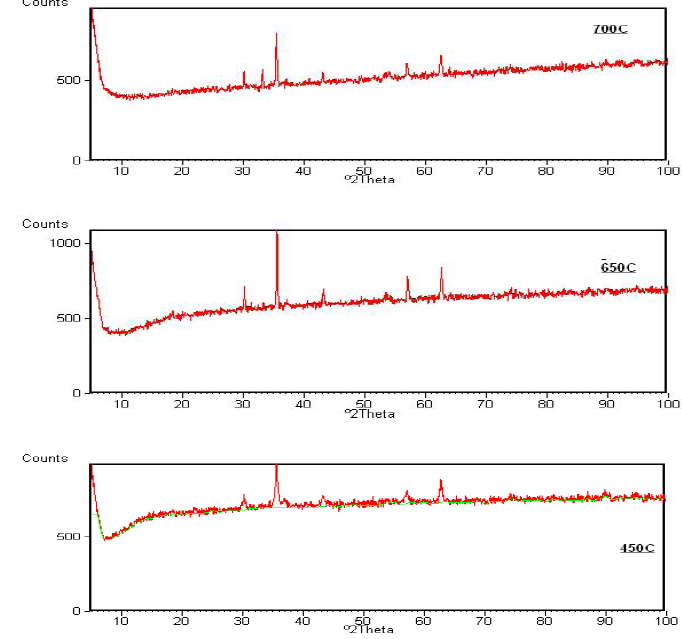
Figure1: X-ray diffraction patterns for Zn1%Co99%Fe2O4
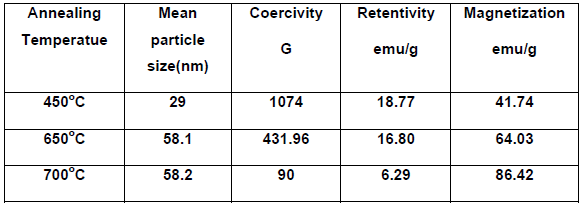
Table 1: Magnetic parameters value for Zn1%Co99%Fe2O4
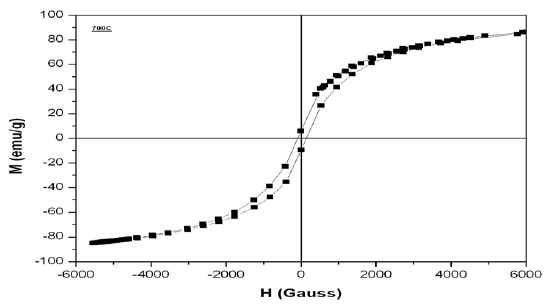
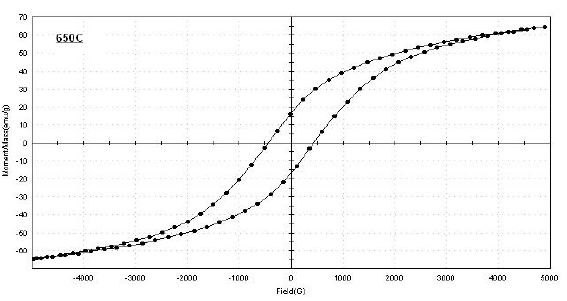
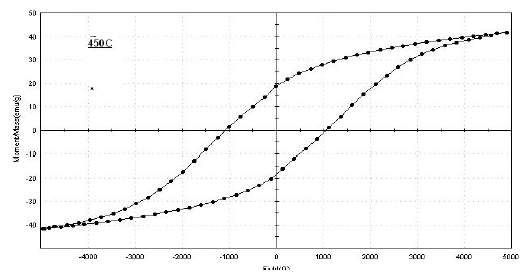
| Mukta V. Limaye et al. ( 6) have obtained magnetization values ranging from 7.1 emu/g to 74.2 emu/g and coercivity 9.47 kOe to 0.93 kOe in Cobalt ferrite nanoparticles, (synthesized by a wet chemical route) samples for annealing temperatures ranging from 100OC upto 1200oC. M. Rajendra et. Al ( 7 ) reported that Cobalt ferrite , synthesized using redox process on heating, the particle size increased w corresponding increase in magnetization values. 1073k, all samples achieved magnetization value close to 73 emu/g. The increase in magnetization w increase in annealing temperature is an indication that the mean domain size of the particles is increasing and atomic spins are getting more and more aligned with the direction of the applied field. Vinod kumar et. Al ( 8 ) synthesized Cobalt ferrite with chemical route they annealed the samples from 373k to 1173k and observed maximum magnetization 74 emu/g. Monatana et al. ( 9 ) prepared Cobalt ferrite nanofusing electrodeposition method and have observed magnetization value 61.8 emu/g of CoFe2o4 /PVP Composite calcined in air for 3hr at 8000c(heating rate- 200C/ minute) having particle size 54 nm.Conclusion The particle size and magnetization were found to increase with annealing temperature. A relatively la magnetization value 86.42 emu/g was observed at annealing temperature 700C. It is worth while to note that this large value has so far not been reported for annealing temperatures of this order. This behavior appears to be a special feature of the citrtate precursor method. |
|
Acknowledgement Thankful to Nalanda Open University, Patna for partial financial support and Dr. R.K.Kotnala, Head, Magnetic standared lab, National Physical laboratory (NPL) New Delhi for magnetic measurement. References 1. Mitsuo Sugimoto “The past, Present and Future of Ferrites”, J. Am. Ceram Soc. 82(2), (1999) 269-280 2. V. Pallai and D.O.Shah, journal of Magnetism and Magnetic Materials 163, (1996),. 243-248. 3. J. Smit and H.P.J. Wijn, Ferrites, (Philips Technical Library, U.K. Edition, London, (1959). 4. Avery N. Goldstein (ed.), Handbook of Nanophase Materials, p.1 (Marcel Dekker, INC, NY, (1997). 5. B.D. Culity, Elements of X-ray diffraction, second edition, Addison-Wiley Pub (1978), 102. 6. Mukta V. Limaye, Sulabha K.Kulkarni, J.Phys.Chem.B 113(2009)9070-9076 7. M. Rajendra, R. C. Pullar, A. K .Bhattacharya, D.Das, S.N.Chintalapudi, C.K.majumdar, J. of. Mag and mater 232( 2001)71-83 8. Vinod Kumar, Annu Rana, M.S.Yadav, R.P.Pant, J. Magn. Magn. mater. (2008)Magma: 54188 9. Montana Sangmanee, Santi Maensiri, Appl. Phys A (2009)97: 167-177. |
|